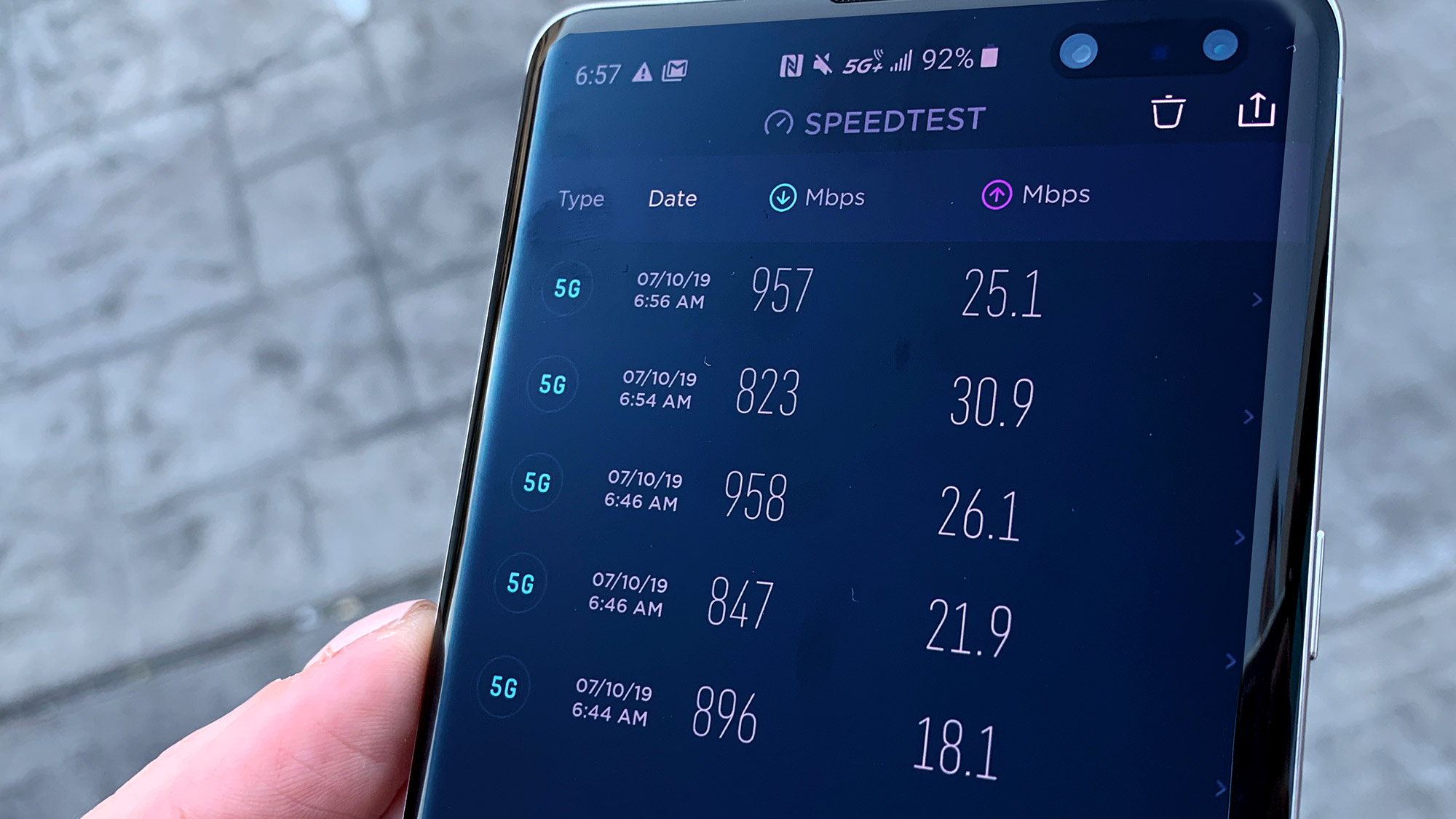AT&T 5G Speed Tests: Blazing Fast But Elusive in Las Vegas

AT&T 5G Testing: Key Takeaways
- We saw an average of 850 Mbps downloads speeds over AT&T’s 5G network in Las Vegas, which is very impressive. But coverage is limited for now.
- It took us only 49 seconds to download the entire Fast and the Furious movie.
- Over 5G, the PUBG mobile game downloaded in 70 seconds versus 5 minutes and 30 seconds over 4G LTE.
- You can expect faster speeds if your phone has AT&T's 5GE in a 5G area. Our iPhone hit 215 Mbps.
It was 7 a.m. and the Las Vegas sun’s punishing rays were already beating down on my head. I squinted my eyes and lifted a Samsung Galaxy S10 5G in the direction of the Flamingo hotel-casino on the Strip, hoping to catch a strong 5G signal on AT&T’s new 5G network. The Ookla Speedtest app’s download speed needle was racing toward the 1 gigabit per second mark, but stopped just short. Damn, I thought.
AT&T’s 5G network (which the carrier calls 5G+) has been live in Vegas for a few weeks, but few people can use it. AT&T was the first carrier to launch its 5G network back in December, with Netgear’s Nighthawk hotspot. But it’s the last to let average consumers who buy a 5G smartphone take advantage of the faster speeds.
To launch its 5G network, AT&T is taking a different approach than its rivals. In the 20-plus cities where AT&T 5G is available, only business customers and developers using 5G-capable devices can get access. The carrier wanted to be first out of the gate — that much is obvious, but it also knows the network isn’t quite ready for regular folks to use.
But AT&T has been refining its software, using lessons from the Nighthawk’s deployment, and working with infrastructure developers, chipset makers and smartphone manufacturers to fine-tune every aspect of the 5G network. Here’s an early glimpse at what you can expect from AT&T’s 5G+.
- More: Make the most of blazing 5G speeds with a fast VPN

Chasing 5G on the Las Vegas Strip
I hunted AT&T’s 5G signal from the Caesars Palace valet to the Fashion Show Mall, then over to the Las Vegas Convention Center, finally landing in a parking lot near the Thomas and Mack Center. I also had three Galaxy S10 5G devices with me, so when one was slowing down (or heating up, as devices can in Vegas during July), I could grab another one to try. That’s not a normal, or ideal, customer experience.
But damn if AT&T’s network isn’t fast. I didn’t cap out at a gig, but I averaged 850 Mbps at every site I visited. AT&T currently uses millimeter-wave spectrum as the basis for 5G, just like Verizon and T-Mobile. That means AT&T delivers ultra-fast speeds, but the connectivity is only strong near a cell site outfitted with a 5G node. I literally had to look for the node and lift the S10 5G in its direction to get peak speeds.
I downloaded The Fast and The Furious, which clocks in with a run-time of 1 hour and 48 minutes, in 49 seconds over 5G. At the Las Vegas Convention Center, the S10 shunted me to LTE when I tried to download PUBG Mobile, a whopping 1.86GB game, installing in 5 minutes and 30 seconds. When I tried it again on another S10 5G with a full 5G signal, PUBG downloaded in 70 seconds.
Get instant access to breaking news, the hottest reviews, great deals and helpful tips.
T-Mobile also just turned on its 5G network in Vegas, and published a map of where 5G signal is strongest in Sin City. It’s a slapdash mix of off-Strip sites with high density and a smattering of Downtown Las Vegas spots. We haven’t gotten a chance to compare T-Mobile’s 5G network in Vegas to AT&T’s, but in our New York tests of the Uncarrier’s mmWave-based network, we found T-Mobile’s coverage to be widespread but slower than expected at 600 Mbps.
Good morning from the Las Vegas Strip, where I’m chasing gigabit speeds on AT&T’s 5G network. Sooooo close. pic.twitter.com/cxet9V3f0fJuly 10, 2019
5G+ vs. 5G E
You might be thinking to yourself: I’m an AT&T subscriber and I already see 5G on my phone every day. Take a second look. That logo says 5G E, and it’s very different from 5G — though still good, reliable and fast. 5G Evolution is the logo AT&T is using for its LTE Advanced network, which widened the highway of capacity and boosted 4G speeds.
I tested an iPhone XS on AT&T’s 5G E network alongside the S10 5G on 5G+, and the iPhone hit 215 Mbps, which is well above the 40 Mbps average download speed AT&T promises with 5G E. The S10 5G capped out at 845 Mbps, which is obviously much faster, but I appreciate that my non-5G phone will also see improved speeds in a 5G world.

Outlook
Like we saw with Verizon in Chicago, mmWave-based 5G networks are incredibly fast, but you have to literally chase down a signal to see the near-instantaneous download speeds that 5G promises. Verizon was faster in our testing, clearing 1 Gbps, but AT&T isn’t far behind. By comparison, Sprint’s mid-band 5G network offers more widespread coverage but much slower speeds.
Now that we’ve tested all four carriers’ 5G networks in various cities around the country, one thing is clear: The next generation of connectivity isn’t quite ready for mass adoption. But we’re getting closer.
Caitlin is a Senior editor for Gizmodo. She has also worked on Tom's Guide, Macworld, PCWorld and the Las Vegas Review-Journal. When she's not testing out the latest devices, you can find her running around the streets of Los Angeles, putting in morning miles or searching for the best tacos.
